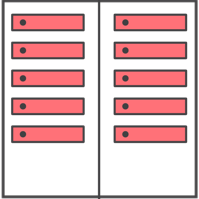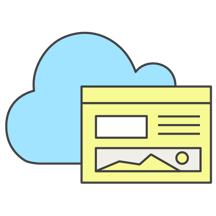Get Started with the Cat Photo Application
Learning Objectives
After completing this unit, you’ll be able to:
- Define cloud computing.
- Differentiate between how workloads run on-premises and in the cloud.
- Describe Amazon Web Services.

You and a few of your friends want to create a web application to share cat photos with one another. To do this, you need to design the architecture. You are building this from scratch—so it’s the perfect opportunity to go cloud native.
To create your cat photo sharing application, you need to use a hosting provider. Since you want to use the cloud, and more specifically AWS, to host this application, you need to learn more about what they can do.
On this journey, you learn fundamental AWS services from a variety of categories, including compute, storage, networking, databases, and monitoring. Let’s get started!
Understand Life Before the Cloud

What do a cat photo application, an online game, a database, and a corporate system architecture all have in common? They are all accessed by people, and they all need to be powered with computers, storage, and networking equipment. As the demand increases, more computers, storage, and networking equipment are needed.
In the past, companies and organizations hosted and maintained this hardware in their own data centers. They needed to allocate entire infrastructure departments to take care of them, resulting in a costly operation that made some workloads and experimentation impossible.
As internet usage became more widespread, the demand for compute, storage, and networking equipment increased. For some companies and organizations, the cost of maintaining a large physical presence was unsustainable.
To solve this problem, cloud computing was created.
What Is the Cloud?

Cloud computing is the on-demand delivery of computer system resources like compute, storage, and networking. You no longer have to manage and maintain your own hardware in your own data centers. Companies like AWS own and maintain these data centers and provide virtualized data center technologies and services to users over the internet.
With the cloud, you no longer need to match your workload to hardware. Instead, you match your hardware to the workload because cloud infrastructure is flexible and logically managed—just like software!
Why Is the Cloud Different from Traditional Hosting Providers?

To help differentiate between running workloads on-premises versus in the cloud, consider the scenario where your developers need to deploy a new feature on your cat photo application. Before they deploy, the team wants to test the feature in a separate quality assurance (QA) environment that has the exact same configurations as production.
If you run your application on-premises, creating this additional environment requires you to buy and install hardware, connect the necessary cabling, provision power, install operating systems, and more. All of these tasks can be time-consuming and take days to perform. Meanwhile, the new product feature’s time-to-market is increasing and your developers are waiting for this environment.
You may be thinking: “Well, that wouldn’t happen if the hardware is already installed and configured.” If that’s the case, you have over-provisioned your hardware, meaning it is allocated but not in use when you do not need it.
If you ran your cat photo application in the cloud, you can replicate the entire environment as often as needed in a matter of minutes or even seconds. Instead of physically installing hardware and connecting cabling, you can logically manage your physical infrastructure over the internet.
This is why cloud computing has become the new normal.
What Is AWS?
Amazon Web Services (AWS) is a secure cloud services platform. It is well-suited for computing power, databases, storage, content delivery, Internet of Things (IoT), artificial intelligence/machine learning (AI/ML), media services, satellites, and a broad spectrum of services needed by many organizations to help them achieve their business goals.
Many customers choose to run their workloads in AWS due to its simplicity, documentation, security, reliability, and ease of integration with other solutions. AWS also provides a vast partner program through the Amazon Partner Network (APN), with tens of thousands of partners across the globe helping companies build successful AWS-based business practices and solutions.
There are two types of partners that you can take advantage of:
- Consulting Partners that help customers build, migrate, and manage their workloads and applications on AWS.
- Technology Partners that provide solutions hosted on the AWS Cloud mostly in the form of a software, which can be found and consumed by customers in the AWS Marketplace.
Depending on your needs, some firms even provide both consulting and software solutions.
Wrap Up
With AWS, you can logically manage your entire infrastructure footprint by consuming APIs. In the next unit, you learn more about the advantages of using the cloud and AWS.
Resources
- External Site: AWS
- External Site: AWS: What is cloud computing?
- External Site: AWS: Types of Cloud Computing
- External Site: AWS: Cloud computing with AWS
- External Site: AWS: Gartner | 2024 Magic Quadrant for Strategic Cloud Platform Services
- External Site: AWS: Cloud Products
